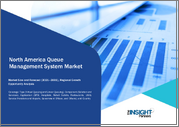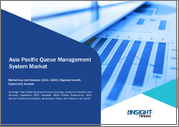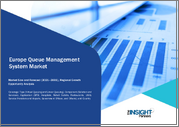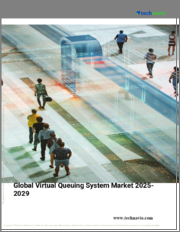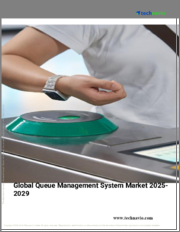
|
시장보고서
상품코드
1806545
대기열 관리 시스템 시장 : 제공 서비스별, 앱 유형별, 솔루션별, 용도별, 전개 유형별, 산업 분야별 - 세계 예측(2025-2030년)Queue Management System Market by Offering, App Type, Solution, Application, Deployment Type, Industry Vertical - Global Forecast 2025-2030 |
||||||
대기열 관리 시스템 시장의 2024년 시장 규모는 8억 7,220만 달러로 평가되었습니다. 2025년에는 9억 3,980만 달러로 성장하여 CAGR은 7.90%, 2030년에는 13억 7,664만 달러에 달할 전망입니다.
| 주요 시장 통계 | |
|---|---|
| 기준 연도 : 2024년 | 8억 7,220만 달러 |
| 추정 연도 : 2025년 | 9억 3,980만 달러 |
| 예측 연도 : 2030년 | 13억 7,664만 달러 |
| CAGR(%) | 7.90% |
현대 비즈니스는 고객 경험이 브랜드 충성도를 정의하고, 운영 우수성이 경쟁 우위를 뒷받침하는 시대에 전개되고 있습니다. 이러한 역동적인 환경의 중심에는 고객 흐름을 효율적으로 관리하고, 대기 시간을 단축하며, 자원 배분을 최적화해야 할 필요성이 있습니다. 대기열 관리 시스템은 초보적인 티켓 디스펜서에서 하드웨어, 소프트웨어, 서비스를 통합하고 다양한 접점에서 원활한 상호작용을 제공하는 정교한 플랫폼으로 진화해 왔습니다.
소비자의 기대치가 높아지고 조직이 디지털 전환의 필요성에 적응하는 가운데, 대기열 관리 솔루션은 서비스 차별화를 실현하는 매우 중요한 요소로 부상하고 있습니다. 이러한 플랫폼은 대면 및 가상 상호작용을 간소화할 뿐만 아니라, 인력 배치 결정과 서비스 프로토콜에 정보를 제공하는 실시간 분석도 제공합니다. 수동 대기열에서 자동화된 데이터 기반 프로세스로의 전환은 운영 전략의 큰 전환을 의미하며, 기업이 수요의 급격한 증가를 예측하고 리소스를 선제적으로 할당하며 고객 만족도를 높일 수 있는 힘을 제공합니다.
이 소개에서는 대기열 관리 시스템이 업계 전반의 서비스 제공을 어떻게 재구성하고 있는지 이해하기 위한 배경을 설명합니다. 또한, 업무 효율성 추구에서 개인화된 경험에 대한 수요에 이르기까지 그 채택의 배경이 되는 경쟁 요인을 강조하고, 빠르게 성숙하고 있는 이 시장을 정의하는 기술 발전, 규제 영향, 세분화의 뉘앙스, 지역적 차이, 경쟁 역학에 대해 더 깊이 있게 탐구할 수 있는 무대를 마련합니다.
대기열 관리 시스템을 재정의하고, 효율성과 참여의 새로운 기회를 촉진하는 기술 및 소비자 주도의 중요한 변화
대기열 관리 환경은 급속한 기술 혁신과 소비자 행동의 진화에 힘입어 변화의 시기를 맞이하고 있습니다. 새로운 클라우드 플랫폼은 하이브리드 배포를 용이하게 하고, 기업은 On-Premise 인프라와 퍼블릭 및 프라이빗 클라우드 환경을 원활하게 통합할 수 있습니다. 이러한 하이브리드 접근 방식을 통해 기업은 중요한 데이터 보안을 유지하면서 운영을 확장하고 오버헤드를 줄일 수 있습니다.
2025년 미국 관세의 대기열 관리 시스템 및 공급망 운영에 미치는 파급 효과와 가격 결정 역학 검증
2025년 미국에서 새로운 관세가 도입되면 대기열 관리 인프라를 평가하고 확장하는 조직에 추가적인 고려사항이 도입될 것입니다. 해외 공급업체에서 조달한 디지털 사이니지 디스플레이, 키오스크 단말기, 티켓 프린터 등 하드웨어 부품은 비용 상승 압력에 시달리고 있습니다. 이러한 상승으로 인해 조달팀은 공급업체와의 관계를 재검토하고 가격 변동을 완화하기 위해 현지 제조 대안을 검토하도록 요구받고 있습니다.
용도 유형별 솔루션, 용도 배포 유형별, 산업별 세분화를 통해 전략적 의사결정의 지침이 되는 실용적인 통찰력 제공
세분화 분석을 통해 얻은 통찰력은 하드웨어, 서비스, 소프트웨어가 교차하며 보급을 촉진하는 다면적인 시장임을 밝혀냈습니다. 하드웨어의 경우, 디지털 사이니지, 키오스크 단말기, 티켓 프린터는 각각 가시성, 셀프 서비스 옵션, 트랜잭션 처리 능력 향상 등 명확한 운영 요구 사항을 충족합니다. 컨설팅 및 구현과 같은 서비스는 조직에 맞는 도입 로드맵을 제공하고, 유지보수 및 지원, 교육은 지속적인 플랫폼 최적화와 사용자 숙련도를 보장합니다. 한편, 분석 및 관리 소프트웨어는 지속적인 성능 모니터링과 전략적 의사결정을 가능하게 합니다.
북미와 남미에서 대기열 관리 솔루션의 진화를 형성하는 지역적 역학 유럽 중동 및 아프리카 아시아태평양의 운영 우선순위 및 도입 동향에 대한 자료입니다.
북미와 남미에서 기업들은 On-Premise의 통제력과 클라우드의 확장성을 결합한 하이브리드 구축 추세가 두드러지게 나타나고 있습니다. 높은 수준의 디지털 인프라 투자와 셀프 서비스 기술에 익숙한 고객 기반에 힘입어 이 지역에서는 고급 분석 및 관리 모듈의 도입이 가속화되고 있습니다. 한편, 서비스 제공업체는 진화하는 고객 수요에 대응하기 위해 지원 프레임워크와 현지화 된 교육 프로그램을 강화하는 데 주력하고 있습니다.
주요 대기열 관리 시스템 제공업체들의 전략적 이니셔티브 시장 모멘텀을 촉진하는 기술 혁신과 경쟁 우위 분석
대기열 관리 분야의 주요 업체들은 기술 혁신과 전략적 파트너십을 통한 차별화 전략을 펼치고 있습니다. 일부 기업들은 클라우드 네이티브 아키텍처에 많은 투자를 하고 있으며, 이를 통해 원활한 업데이트와 통합을 가능하게 하는 동시에 중견기업 및 엔터프라이즈 고객의 진입 장벽을 낮추고 있습니다. 또한, 핵심적인 티켓팅 기능을 채택하고, 분석 및 인력 최적화 모듈을 단계적으로 추가할 수 있는 모듈형 플랫폼 개발에 집중하는 기업도 있습니다.
업계 리더들이 대기열 관리의 혁신을 활용하여 역동적인 환경에서 서비스 제공을 최적화하고 지속 가능한 성장을 실현하기 위한 전략적 로드맵 제시
업계 리더들은 보다 광범위한 고객 경험 이니셔티브와 연계된 대기열 관리에 대한 통합적 접근 방식을 우선시함으로써 진행 중인 서비스 상호 작용의 디지털화를 활용할 수 있습니다. 적절한 경우 클라우드 퍼스트 아키텍처를 채택함으로써 조직은 변화하는 수요 패턴에 대응할 수 있는 빠른 확장성과 민첩성을 확보할 수 있습니다. 엄격한 데이터 주권 및 지연 요구사항이 있는 환경에서는 하이브리드 모델을 고려해야 하며, 제어와 유연성의 균형을 유지해야 합니다.
대기열 관리 시스템 통찰력을 위한 다단계 데이터 수집 양적 분석 질적 인터뷰와 검증 프로토콜을 중시하는 투명성 높은 조사 프레임워크.
이번 조사에서는 대기열 관리 시스템에 대한 통찰력을 종합적으로 조사하고 검증하기 위해 다단계 접근 방식을 채택했습니다. 첫 번째 단계에서는 업계 신문, 규제 당국 신고, 기술 벤더의 문서를 통해 2차 데이터를 수집했습니다. 이 기반은 다양한 산업 분야의 고위 경영진, 솔루션 아키텍트, 서비스 관리자, IT 디렉터에 대한 심층 인터뷰를 포함한 1차 조사를 통해 강화되었습니다.
기술 동향의 주요 하이라이트 의사결정에 도움이 되는 대기열 관리 시스템의 운영 효율성과 경쟁의 중요성
대기열 관리 시스템의 역학을 조사한 결과, 기술 발전, 규제 상황, 고객의 기대가 혁신을 촉진하기 위해 융합되는 상황을 확인할 수 있었습니다. 주요 주제는 클라우드와 하이브리드 구축의 중요성 증대, 원격 운영을 위한 모바일 및 웹 용도의 전략적 중요성, 컨설팅, 유지보수, 교육을 통합한 서비스 모델의 가치 등입니다.
목차
제1장 서문
제2장 조사 방법
제3장 주요 요약
제4장 시장 개요
제5장 시장 역학
제6장 시장 인사이트
- Porter's Five Forces 분석
- PESTEL 분석
제7장 미국 관세의 누적 영향 2025
제8장 대기열 관리 시스템 시장 : 제공별
- 하드웨어
- 디지털 사이니지
- 키오스크
- 티켓 프린터
- 서비스
- 컨설팅 및 구현
- 유지관리 및 지원
- 트레이닝
- 소프트웨어
- 분석
- 관리 소프트웨어
제9장 대기열 관리 시스템 시장 : 앱 유형별
- 모바일 기반
- 웹 기반
제10장 대기열 관리 시스템 시장 : 솔루션별
- 선형 큐잉
- 가상 큐잉
제11장 대기열 관리 시스템 시장 : 용도별
- 예약 관리
- 쿼리 처리
- 실시간 모니터링
- 인력 최적화
제12장 대기열 관리 시스템 시장 : 전개 유형별
- 클라우드
- 프라이빗 클라우드
- 퍼블릭 클라우드
- 하이브리드
- On-Premise
제13장 대기열 관리 시스템 시장 : 업계별
- 은행 금융 보험
- 정부
- 헬스케어
- IT 및 통신
- 제조업
- 소매
- 운송
제14장 아메리카의 대기열 관리 시스템 시장
- 미국
- 캐나다
- 멕시코
- 브라질
- 아르헨티나
제15장 유럽, 중동 및 아프리카의 대기열 관리 시스템 시장
- 영국
- 독일
- 프랑스
- 러시아
- 이탈리아
- 스페인
- 아랍에미리트
- 사우디아라비아
- 남아프리카공화국
- 덴마크
- 네덜란드
- 카타르
- 핀란드
- 스웨덴
- 나이지리아
- 이집트
- 튀르키예
- 이스라엘
- 노르웨이
- 폴란드
- 스위스
제16장 아시아태평양의 대기열 관리 시스템 시장
- 중국
- 인도
- 일본
- 호주
- 한국
- 인도네시아
- 태국
- 필리핀
- 말레이시아
- 싱가포르
- 베트남
- 대만
제17장 경쟁 구도
- 시장 점유율 분석, 2024
- FPNV 포지셔닝 매트릭스, 2024
- 경쟁 분석
- 4tuna OU
- Advantech Co., Ltd.
- AKIS Technologies
- ATT Systems Group
- Aurionpro Solutions Limited
- Awebstar Technologies Pte Ltd.
- CleverQ by B.I.C. GmbH
- E. Oppermann GmbH
- Greetly by Officespace
- jrni Inc.
- Lavi Industries
- Malia Group
- Online Token Inc.
- Q-Matic AB
- Q-nomy Inc.
- QLess, Inc.
- Qminder Ltd
- SEDCO's Company Limited
- Skiplino Technologies WLL
- timeacle GmbH & Co. KG
- VersionX Innovations Pvt. Ltd.
- VirtuaQ
- Waitwhile Inc.
- Wavetec
- Xtreme Media Pvt. Ltd.
- Oracle Corporation
- NextMe Inc.
제18장 리서치 AI
제19장 리서치 통계
제20장 리서치 컨택트
제21장 리서치 기사
제22장 부록
LSH 25.09.12The Queue Management System Market was valued at USD 872.20 million in 2024 and is projected to grow to USD 939.80 million in 2025, with a CAGR of 7.90%, reaching USD 1,376.64 million by 2030.
| KEY MARKET STATISTICS | |
|---|---|
| Base Year [2024] | USD 872.20 million |
| Estimated Year [2025] | USD 939.80 million |
| Forecast Year [2030] | USD 1,376.64 million |
| CAGR (%) | 7.90% |
Modern businesses operate in an era where customer experience defines brand loyalty and operational excellence underpins competitive advantage. At the heart of this dynamic environment lies the need to manage customer flows efficiently, reduce perceived wait times, and optimize resource allocation. Queue management systems have evolved from rudimentary ticket dispensers to sophisticated platforms that integrate hardware, software, and services, delivering seamless interactions across diverse touchpoints.
As organizations adapt to rising consumer expectations and the imperative for digital transformation, queue management solutions have emerged as pivotal enablers of service differentiation. These platforms not only streamline in-person and virtual interactions but also provide real-time analytics that inform staffing decisions and service protocols. The transition from manual queues to automated, data-driven processes represents a significant shift in operational strategy, empowering businesses to predict demand surges, allocate resources proactively, and enhance customer satisfaction.
This introduction frames the context for understanding how queue management systems are reshaping service delivery across industries. It underscores the driving factors behind their adoption-from the pursuit of operational efficiency to the demand for personalized experiences-and sets the stage for a deeper exploration of the technological advancements, regulatory influences, segmentation nuances, regional variances, and competitive dynamics that define this rapidly maturing market.
Critical Technological and Consumer-Driven Transformations Redefining Queue Management Systems and Fueling New Opportunities for Efficiency and Engagement
The landscape of queue management has undergone transformative shifts propelled by rapid technological innovation and evolving consumer behaviors. New cloud platforms now facilitate hybrid deployments, allowing organizations to blend on premise infrastructure with public and private cloud environments seamlessly. This hybrid approach enables businesses to maintain critical data security while scaling operations and reducing overhead.
Simultaneously, the rise of mobile-based and web-based applications has empowered customers to engage with service providers remotely, reserving time slots in advance and reducing physical crowding. Virtual queuing platforms that provide real-time updates and digital ticketing have gained traction, particularly in high-traffic environments where flexibility and convenience are paramount. These advancements not only enhance user experience but also generate valuable usage data, enabling continuous optimization of service flows.
On the hardware front, digital signage, kiosks, and ticket printers have been reimagined to integrate seamlessly with analytics engines and management software. This convergence of hardware and software fosters a unified monitoring environment, delivering insights into footfall patterns, service bottlenecks, and performance metrics. In parallel, service offerings such as consulting, implementation, training, maintenance, and support have evolved into end-to-end engagements, ensuring that organizations extract maximum value from their queue management investments.
These technological and service-oriented shifts signal a new era for queue management, where agility, data intelligence, and customer-centric design converge to shape next-generation service ecosystems.
Examining the Ripple Effects of 2025 United States Tariffs on Queue Management System Supply Chains Operations Adoption and Pricing Dynamics
The implementation of new United States tariffs in 2025 has introduced additional considerations for organizations evaluating or expanding their queue management infrastructure. Hardware components such as digital signage displays, kiosks, and ticket printers sourced from overseas suppliers have experienced upward cost pressures. These increases have prompted procurement teams to reassess supplier relationships and consider local manufacturing alternatives to mitigate pricing volatility.
Moreover, the elevated tariffs have cascaded into maintenance and support agreements, as service providers adjust labor and parts costs to reflect higher import expenses. This environment has spurred innovation in maintenance models, with more clients seeking remote diagnostic tools and predictive maintenance solutions to reduce the frequency of on-site interventions. The shift towards analytics-driven support not only addresses cost concerns but also enhances system reliability through proactive issue detection.
For software platforms, the tariff-induced rise in hardware expenses has accelerated interest in cloud-based solutions that reduce dependency on on premise equipment. Organizations are increasingly exploring SaaS offerings that deliver queue management functionality via web-based and mobile applications, allowing them to circumvent hardware surcharges. This pivot underscores the importance of flexible deployment models in a tariff-sensitive climate.
Overall, the tariff landscape of 2025 has stimulated strategic realignments across procurement, deployment planning, and support services. As businesses navigate these headwinds, the emphasis on digital transformation and cloud adoption will continue to shape the evolution of queue management strategies.
Unveiling Actionable Insights from Offering App Type Solution Application Deployment Type and Industry Vertical Segmentations to Guide Strategic Decisions
Insights from the segmentation analysis reveal a multifaceted market where hardware, services, and software offerings intersect to drive adoption. Within hardware, digital signage, kiosks, and ticket printers each serve distinct operational needs, enhancing visibility, self-service options, and transaction throughput respectively. Services such as consulting and implementation equip organizations with tailored deployment roadmaps, while maintenance and support along with training ensure ongoing platform optimization and user proficiency. Meanwhile, analytics and management software unlock continuous performance monitoring and strategic decision making.
Examining application delivery modes, both mobile-based and web-based offerings cater to the rising demand for remote queue engagement, enabling users to join virtual lines and receive real-time updates through devices they carry daily. This duality of access channels underscores the necessity for solutions that are both intuitive and secure.
When evaluating solution types, linear queuing remains integral for straightforward ticketing scenarios, whereas virtual queuing addresses the need for dynamic resource allocation in fluctuating environments. Application focus spans appointment management, query handling, real-time monitoring, and workforce optimization, reflecting the breadth of organizational priorities from scheduling precision to rapid response and staff efficiency.
Deployment preferences vary, with cloud, hybrid, and on premise models accommodating differing security, scalability, and control requirements. The cloud option further differentiates into private and public environments, allowing firms to align deployments with compliance mandates and cost structures. Finally, industry vertical segmentation highlights tailored adoption patterns across banking finance and insurance, government, healthcare, IT and telecom, manufacturing, retail, and transportation, each with unique compliance landscapes and customer expectations.
Regional Dynamics Shaping the Evolution of Queue Management Solutions Across Americas Europe Middle East Africa and Asia Pacific Operational Priorities and Adoption Trends
Across the Americas, organizations have demonstrated a notable propensity for hybrid deployments that marry on premise control with cloud scalability. High levels of digital infrastructure investment and a customer base accustomed to self-service technologies have accelerated the adoption of sophisticated analytics and management modules in the region. Meanwhile, service providers concentrate on enhancing support frameworks and localized training programs to meet evolving client demands.
In Europe Middle East and Africa, regulatory compliance and data sovereignty have shaped a different adoption narrative, with private cloud and on premise installations frequently preferred in highly regulated sectors such as finance and healthcare. Simultaneously, the region's rising tourism and retail sectors have elevated interest in mobile-based queuing applications and virtual queuing solutions that offer multilingual support and seamless integrations with loyalty programs.
The Asia Pacific region presents a dynamic blend of adoption drivers, fueled by rapid urbanization, increasing consumer expectations, and government initiatives to modernize public services. Countries in this region are pioneering real-time monitoring solutions and appointment management platforms within high-traffic government facilities and healthcare centers. Additionally, transportation hubs are adopting virtual queuing to streamline passenger flows, while retail and manufacturing verticals leverage digital signage and kiosks to manage peak hour surges.
Though each region navigates distinctive regulatory and operational frameworks, the common thread remains a commitment to leveraging queue management technologies as catalysts for customer satisfaction and operational resilience.
In Depth Analysis of Leading Queue Management System Providers Their Strategic Initiatives Technological Innovations and Competitive Advantages Driving Market Momentum
Leading providers in the queue management domain have demonstrated differentiated strategies that blend technological innovation with strategic partnerships. Several firms have invested heavily in cloud-native architectures, enabling seamless updates and integrations while lowering barriers to entry for midmarket and enterprise clients. Others have focused on developing modular platforms that allow clients to adopt core ticketing functionality and progressively add analytics or workforce optimization modules.
Strategic partnerships between technology vendors and systems integrators have further expanded service capabilities, combining hardware expertise with deep domain knowledge in verticals such as healthcare and finance. This collaboration has spawned customized solutions that address sector-specific compliance requirements and user experience standards.
In terms of innovation, forward-thinking companies have introduced artificial intelligence and machine learning components into their analytics suites, offering predictive insights on peak hours, staff allocation, and customer throughput. Concurrently, investments in user interface design have yielded mobile and web applications with intuitive scheduling workflows and personalized notification systems, enhancing engagement and reducing no-show rates.
Competitive initiatives also include geographic expansion, with some providers establishing regional centers of excellence to deliver localized support and consulting services. By aligning product roadmaps with emerging trends such as contactless interactions and remote queuing, these companies are positioning themselves to lead the next phase of market evolution.
Strategic Roadmap for Industry Leaders to Harness Queue Management Innovations Optimize Service Delivery and Achieve Sustainable Growth in Dynamic Environments
Industry leaders can capitalize on the ongoing digitization of service interactions by prioritizing an integrated approach to queue management that aligns with broader customer experience initiatives. By adopting cloud-first architectures where appropriate, organizations can ensure rapid scalability and agility in response to fluctuating demand patterns. Hybrid models should be considered for environments with strict data sovereignty or latency requirements, balancing control with flexibility.
To bolster adoption and user satisfaction, it is recommended to invest in training programs that equip front-line staff with both technical proficiency and skills in customer engagement. Additionally, leveraging analytics platforms enriched with artificial intelligence capabilities will enable more accurate demand forecasting and proactive staffing adjustments, reducing wait times and improving service quality.
Collaboration with strategic partners, including systems integrators and vertical specialists, can accelerate deployment timelines and ensure solutions meet industry-specific compliance and user experience benchmarks. Engaging in pilot programs for virtual queuing and mobile-based booking can gather real-world feedback that informs wider rollouts and feature enhancements.
Finally, embedding feedback loops into the queue management ecosystem-through real-time surveys and performance dashboards-will empower continuous improvement. By adopting an iterative approach, organizations can refine processes, enhance customer engagement, and solidify their position as service leaders in their respective markets.
Transparent Research Framework Emphasizing Multi Stage Data Collection Quantitative Analysis Qualitative Interviews and Validation Protocols for Queue Management System Insights
This research utilized a multi stage approach to ensure comprehensive coverage and validation of queue management system insights. The first stage involved gathering secondary data from industry publications, regulatory filings, and technology vendor documentation. This foundation was augmented by primary research, which included in depth interviews with senior executives, solution architects, service managers, and IT directors from diverse industry verticals.
Quantitative data collection was conducted through structured surveys, capturing deployment preferences, feature adoption rates, and satisfaction metrics across hardware, software, and service segments. These findings were cross verified through qualitative discussions and case study reviews, enabling a nuanced understanding of implementation challenges and best practices.
Data triangulation was applied by comparing survey results with financial reports and publicly disclosed performance indicators, ensuring consistency and reliability. Further validation workshops with subject matter experts provided critical feedback on emerging trends, regional peculiaries, and the impacts of regulatory and tariff changes.
This layered methodology yielded a robust set of insights, balancing breadth with depth and enabling practical recommendations that reflect the complex realities faced by organizations deploying queue management solutions today.
Synthesis of Key Findings Highlighting Technological Trends Operational Efficiencies and Competitive Imperatives in Queue Management Systems for Informed Decision Making
The exploration of queue management system dynamics reveals a landscape in which technological advancement, regulatory influences, and customer expectations converge to drive innovation. Key themes include the increasing prominence of cloud and hybrid deployments, the strategic importance of mobile and web applications for remote engagement, and the value of service models that integrate consulting, maintenance, and training.
Furthermore, the analysis of segmentation data underscores how hardware choices, software capabilities, deployment preferences, and vertical demands collectively shape adoption patterns. Regional insights highlight the dual imperatives of complying with local regulations and aligning with customer service norms, while competitive profiling illuminates the diverse strategies employed by leading providers to differentiate through innovation and partnerships.
Taken together, these findings offer a cohesive view of the queue management ecosystem, equipping decision makers with the context necessary to evaluate solution suitability, anticipate operational challenges, and identify strategic opportunities. By synthesizing technological, economic, and regulatory factors, this conclusion lays the groundwork for informed planning and prioritized action in pursuit of enhanced service delivery and organizational resilience.
Table of Contents
1. Preface
- 1.1. Objectives of the Study
- 1.2. Market Segmentation & Coverage
- 1.3. Years Considered for the Study
- 1.4. Currency & Pricing
- 1.5. Language
- 1.6. Stakeholders
2. Research Methodology
- 2.1. Define: Research Objective
- 2.2. Determine: Research Design
- 2.3. Prepare: Research Instrument
- 2.4. Collect: Data Source
- 2.5. Analyze: Data Interpretation
- 2.6. Formulate: Data Verification
- 2.7. Publish: Research Report
- 2.8. Repeat: Report Update
3. Executive Summary
4. Market Overview
- 4.1. Introduction
- 4.2. Market Sizing & Forecasting
5. Market Dynamics
- 5.1. Integration of AI-driven predictive analytics for customer wait time optimization
- 5.2. Implementation of contactless self-service kiosks with mobile check-in
- 5.3. Adoption of cloud-based queue management solutions for remote scalability
- 5.4. Real-time data dashboards enabling dynamic resource allocation across branches
- 5.5. Personalization of customer experiences through data-driven queue prioritization
- 5.6. Influence of IoT sensor networks on real-time crowd flow monitoring in venues
- 5.7. Use of virtual queuing and mobile notifications to reduce on-site congestion
- 5.8. Compliance with data privacy regulations shaping queue management information handling
6. Market Insights
- 6.1. Porter's Five Forces Analysis
- 6.2. PESTLE Analysis
7. Cumulative Impact of United States Tariffs 2025
8. Queue Management System Market, by Offering
- 8.1. Introduction
- 8.2. Hardware
- 8.2.1. Digital Signage
- 8.2.2. Kiosks
- 8.2.3. Ticket Printers
- 8.3. Services
- 8.3.1. Consulting And Implementation
- 8.3.2. Maintenance And Support
- 8.3.3. Training
- 8.4. Software
- 8.4.1. Analytics
- 8.4.2. Management Software
9. Queue Management System Market, by App Type
- 9.1. Introduction
- 9.2. Mobile-based
- 9.3. Web-based
10. Queue Management System Market, by Solution
- 10.1. Introduction
- 10.2. Linear Queuing
- 10.3. Virtual Queuing
11. Queue Management System Market, by Application
- 11.1. Introduction
- 11.2. Appointment Management
- 11.3. Query Handling
- 11.4. Real-time Monitoring
- 11.5. Workforce Optimization
12. Queue Management System Market, by Deployment Type
- 12.1. Introduction
- 12.2. Cloud
- 12.2.1. Private Cloud
- 12.2.2. Public Cloud
- 12.3. Hybrid
- 12.4. On Premise
13. Queue Management System Market, by Industry Vertical
- 13.1. Introduction
- 13.2. Banking Finance And Insurance
- 13.3. Government
- 13.4. Healthcare
- 13.5. IT and Telecom
- 13.6. Manufacturing
- 13.7. Retail
- 13.8. Transportation
14. Americas Queue Management System Market
- 14.1. Introduction
- 14.2. United States
- 14.3. Canada
- 14.4. Mexico
- 14.5. Brazil
- 14.6. Argentina
15. Europe, Middle East & Africa Queue Management System Market
- 15.1. Introduction
- 15.2. United Kingdom
- 15.3. Germany
- 15.4. France
- 15.5. Russia
- 15.6. Italy
- 15.7. Spain
- 15.8. United Arab Emirates
- 15.9. Saudi Arabia
- 15.10. South Africa
- 15.11. Denmark
- 15.12. Netherlands
- 15.13. Qatar
- 15.14. Finland
- 15.15. Sweden
- 15.16. Nigeria
- 15.17. Egypt
- 15.18. Turkey
- 15.19. Israel
- 15.20. Norway
- 15.21. Poland
- 15.22. Switzerland
16. Asia-Pacific Queue Management System Market
- 16.1. Introduction
- 16.2. China
- 16.3. India
- 16.4. Japan
- 16.5. Australia
- 16.6. South Korea
- 16.7. Indonesia
- 16.8. Thailand
- 16.9. Philippines
- 16.10. Malaysia
- 16.11. Singapore
- 16.12. Vietnam
- 16.13. Taiwan
17. Competitive Landscape
- 17.1. Market Share Analysis, 2024
- 17.2. FPNV Positioning Matrix, 2024
- 17.3. Competitive Analysis
- 17.3.1. 4tuna OU
- 17.3.2. Advantech Co., Ltd.
- 17.3.3. AKIS Technologies
- 17.3.4. ATT Systems Group
- 17.3.5. Aurionpro Solutions Limited
- 17.3.6. Awebstar Technologies Pte Ltd.
- 17.3.7. CleverQ by B.I.C. GmbH
- 17.3.8. E. Oppermann GmbH
- 17.3.9. Greetly by Officespace
- 17.3.10. jrni Inc.
- 17.3.11. Lavi Industries
- 17.3.12. Malia Group
- 17.3.13. Online Token Inc.
- 17.3.14. Q-Matic AB
- 17.3.15. Q-nomy Inc.
- 17.3.16. QLess, Inc.
- 17.3.17. Qminder Ltd
- 17.3.18. SEDCO's Company Limited
- 17.3.19. Skiplino Technologies WLL
- 17.3.20. timeacle GmbH & Co. KG
- 17.3.21. VersionX Innovations Pvt. Ltd.
- 17.3.22. VirtuaQ
- 17.3.23. Waitwhile Inc.
- 17.3.24. Wavetec
- 17.3.25. Xtreme Media Pvt. Ltd.
- 17.3.26. Oracle Corporation
- 17.3.27. NextMe Inc.







